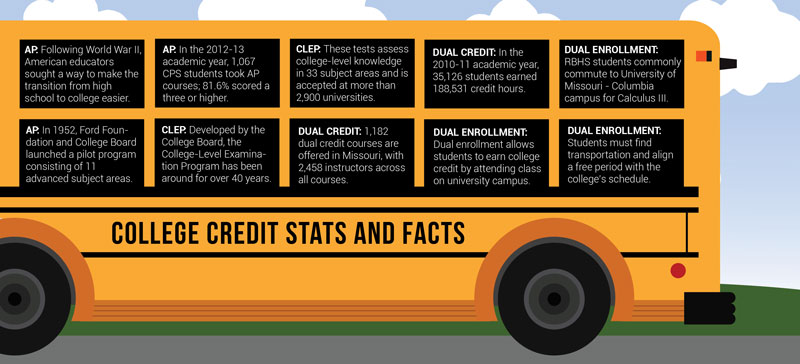infographic by Joy Park
As an RBHS student, senior Faramola Shonekan has tapped into many of the opportunities offered by the school to provide college credit.
RBHS offers myriad opportunities to achieve college credit, including dual credit, dual enrollment, College Level Examination Programs (CLEP) exams and Advanced Placement (AP) courses and tests, with the latter being the most popular, guidance counselor Rachel Reed said. During her time at RBHS, Shonekan has taken dual credit and AP classes, for many reasons.
“I wanted to be challenged intellectually, and I get college credit for it and that makes college cheaper which is something that’s very nice for my family,” Shonekan said.
Shonekan is one of the many students who take AP classes at RBHS. But the class does not guarantee college credit, while dual enrollment and dual credit do, pending success in the class.
“If [students] score high enough on the AP test, they can get the credit, but [the scores] that colleges accept are different,” Reed explained. “Some colleges accept a three [out of five]. Some colleges only accept a four or higher. Some colleges won’t accept the credit even if you take the test and get a five.”
As over 68 percent of high school students pursue a collegiate education after high school according to the U.S. Bureau of Labor Statistics, RBHS students opt to enroll in AP classes or choose another method of credit in order to prepare for the collegiate academic atmosphere.
Because AP classes do not guarantee college credit, however, RBHS Gifted Education instructor, Gwen Struchtemeyer, does not consider the classes to be a method of gaining college credit.
“AP classes are supposed to closely mirror a college course as far as expectations,” Struchtemeyer said. “But a student could get a five on an AP test, but depending on where they go to school, they might not get college credit for it.”
While AP courses do not guarantee college credit dual enrollment, sometimes called direct credit, and dual credit, are both methods to garner the credit.
“For dual credit, like our college algebra class, [students] take the class here at RBHS but get the college credit as long as they score a certain grade in the class and have met the college’s requirements,” Reed said. “There’s also dual enrollment where you are taking a college class and earning high school credit, so you are actually going to that college’s campus and taking the class through the college.”
Dual enrollment, however, is not a popular method for attaining college credit because of the logistical issues and particularly challenging curriculum. Students who take dual enrollment classes, most commonly those who travel to the University of Missouri – Columbia campus and take Calculus 3, must find transportation and align an AUT or free period with the college’s schedule.
Another prong of the trident of college credit is the CLEP exam, a little known method to attain the sought after credit.

“Students can take CLEP exams in a variety of different areas, like psychology, foreign languages, lots of core classes,” Reed said. “You can earn credit that way, which is obviously cheaper than taking the class on college campus,” Reed said.
While these classes may be more challenging, both Reed and Struchtemeyer suggest them for economic purposes. Shonekan, however, cites a different motivation for taking the classes.
“It trains you for college it helps you prepare for college instead of just taking the regular classes,” Shonekan said. “You’re actually in a competitive class and it helps you get into the swing of what college is like; it gives you a little intro.”
Students explore methods of gaining college credit
March 11, 2016
0
Tags:
More to Discover



















































































